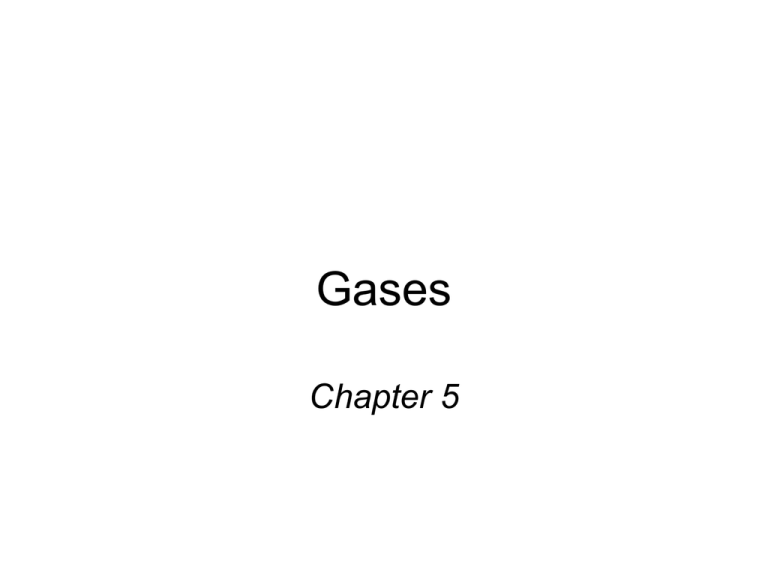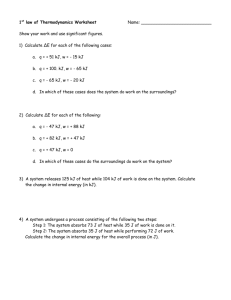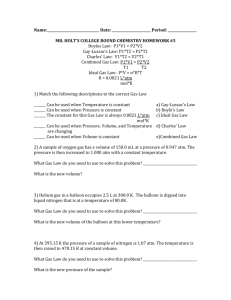chapter_5_Bo - HCC Learning Web
advertisement

Gases Chapter 5 Substances that exist as gases Elements that exist as gases at 250C and 1 atmosphere 5.1 Our Atmosphere: 10 miles 0.2 atm 4 miles 0.5 atm Sea level1 atm • exerts pressure on earth • more at sea level • less on mountain top • The air we breathe: • 79% N2 • 21% O2 Pressure of Gas Atmospheric pressure 1 atm = 760 mmHg = 760 torr (1 torr = 1mm Hg) 1 atm = 101,325 Pa 1 atm = 101 kPa The Gas Laws PV = nRT R is the gas constant 4 variables are involved: • P = pressure • V = volume • n = # of moles • T = temperature (in Kelvin) Ideal Gas Equation Ideal gas is a hypothetical gas whose pressure-volumetemperature behavior can be completely accounted for by the ideal gas equation. Pressure and Temperature • Pressure = force/area (we will use torr, mm Hg, Pa & atm) • Always use Kelvin temperature (K) K = ° C + 273 What is the pressure of the gas (in atm) when 5.0 moles of CO gas are present in a container of 20.0 L at 27 oC? n= 5.0mole, V=20.0L, T= 27 oC=(27+273.15)K=300.15K PV=nRT P=nRT / V = 5.0mole*0.082 L• atm / (mol • K)*300.15K/20.0L = 6.15 atm The conditions 0 0C and 1 atm are called standard temperature and pressure (STP). Experiments show that at STP, 1 mole of an ideal gas occupies 22.414 L. Molar volume of gas 1 mole of gas at STP = 22.4 Liters 2 moles of gas at STP = 44.8 L R = 0.0821 L • atm / (mol • K) = 8.314 J/(K·mol) What is the volume (in liters) occupied by 49.8 g of HCl at STP? n = 49.8 g x 1 mol HCl = 1.37 mol 36.45 g HCl 1 mole of gas at STP = 22.4 Liters V = 1.37 mol x 22.4 L/mol = 30.6 L Argon is an inert gas used in lightbulbs to retard the vaporization of the filament. A certain lightbulb containing argon at 1.20 atm and 18 0C is heated to 85 0C at constant volume. What is the final pressure of argon in the lightbulb (in atm)? PV = nRT n, V and R are constant nR P = = constant T V P1 P2 = T1 T2 P1 = 1.20 atm T1 = 291 K P2 = ? T2 = 358 K T2 = 1.20 atm x 358 K = 1.48 atm P2 = P1 x 291 K T1 Density (d) Calculations PM m d= = V RT m is the mass of the gas in g M is the molar mass of the gas Molar Mass (M ) of a Gaseous Substance dRT M= P d is the density of the gas in g/L 5.4 What is the density of HCl gas in grams per liter at 700 mmHg and 25 oC? PM m d= = V RT P=700mmHg=700/760atm=0.92atm T= 25 oC=25+273.15K=298.15K d = 0.92 atm x 36.45 g/mol 0.0821 =1.37g/L L•atm mol•K x 298.15 K What is the molar mass (g/mol) of 7.10 grams of gas whose volume is 5.40 L at 741 torr and 40 oC? dRT M= P T=313.15K M= 7.10 g m = = 1.31 d= 5.40 L V P= 741torr=741/760atm=0.975atm g 1.31 L M = 34.6 g/mol x 0.0821 L•atm mol•K x 313.15 K 0.975 atm g L Gas Stoichiometry The combustion process for methane is CH4(g) + 2 O2(g) CO2(g) + 2 H2O(l) If 15.0 moles of methane are reacted, what is the volume of carbon dioxide (in L) produced at 23.0 oC and 0.985 atm? x 1CO2/1CH4 15 mole CH4 ---------------- 15 mole CO2 V= nRT = P L•atm x 296.15 K mol•K = 369.8 L 0.985 atm 15mol x 0.0821 Dalton’s Law of Partial Pressures Partial pressure is the pressure of the individual gas in the mixture. V and T are constant P1 P2 Ptotal = P1 + P2 Consider a case in which two gases, A and B, are in a container of volume V. nART PA = V nA is the number of moles of A nBRT PB = V nB is the number of moles of B PT = PA + PB PA = XA PT nA XA = nA + nB nB XB = nA + nB PB = XB PT Pi = Xi PT mole fraction (Xi) = ni nT A sample of natural gas contains 8.24 moles of CH4, 0.421 moles of C2H6, and 0.116 moles of C3H8. If the total pressure of the gases is 1.37 atm, what is the partial pressure of propane (C3H8)? Pi = Xi PT PT = 1.37 atm 0.116 Xpropane = 8.24 + 0.421 + 0.116 = 0.0132 Ppropane = 0.0132 x 1.37 atm = 0.0181 atm Kinetic Molecular Theory of Gases 1. A gas is composed of molecules that are separated from each other by distances far greater than their own dimensions. The molecules can be considered to be points; that is, they possess mass but have negligible volume. 2. Gas molecules are in constant motion in random directions, and they frequently collide with one another. Collisions among molecules are perfectly elastic. 3. Gas molecules exert neither attractive nor repulsive forces on one another. 4. The average kinetic energy of the molecules is proportional to the temperature of the gas in kelvins. Any two gases at the same temperature will have the same average kinetic energy u2 = (u12 + u22 + …+ uN2)/N KE a T KE = ½ mu2 Mean square speed








